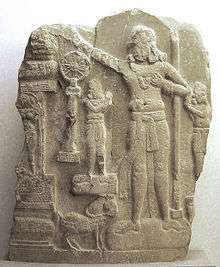
Chakravartin
Chakravartin (Sanskrit cakravartin, Pali cakkavattin) is an ancient Indian term used to refer to an ideal universal ruler who rules ethically and benevolently over the entire world. Such a ruler's reign is called sarvabhauma. It is a bahuvrīhi, figuratively meaning "whose wheels are moving", in the sense of "whose chariot is rolling everywhere without obstruction". It can also be analysed as an 'instrumental bahuvrīhi: "through whom the wheel is moving" in the meaning of "through whom the Dharmachakra ("Wheel of the Dharma) is turning" (most commonly used in Buddhism and Hinduism).
The first references to a cakravala cakravrtin appear in monuments from the time of the Maurya Empire (322–185 BCE), dedicated to Chandragupta Maurya and his grandson Ashoka. It has not been generally used for any other historic figure. In Buddhism, the chakravarti came to be considered the secular counterpart of a buddha. In general, the term applies to temporal as well as spiritual kingship and leadership, particularly in Buddhism and Jainism. In Hinduism, the term generally denotes a powerful ruler whose dominion extended to the entire earth.
Podcasts:

